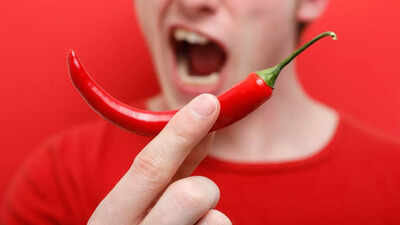The scientific reason we love spicy food |

The great cosmic joke of spicy food is that it was never meant for us to enjoy. Nature designed the chilli as a tiny red “do not touch” sign, and humans, being the only species that sees a warning label as a personal challenge, took one bite and said, “Interesting… let’s build an entire cuisine around this.”Because contrary to what we pretend, spice isn’t a taste at all. It’s pain, dressed up as flavour. Capsaicin, the chemical at the heart of all this drama, doesn’t flirt with your taste buds. It goes straight to the pain receptors that normally signal actual burning. Your nervous system interprets it as a small emergency. Your eyes water, your nose begins a gentle waterfall impression, your pores stage a monsoon. It’s the body doing everything short of throwing a chair through a window and evacuating the building.And yet, bizarrely, this is the point at which humans say: “Lovely. More.”The secret lies in how the brain rewires itself. The first encounter with heat is a shock: a loud, bright, unambiguous “No.” But repetition dulls the alarm. The same way your brain learns that a rollercoaster won’t fling you into orbit or that the horror film won’t climb out of the screen, it learns that chilli won’t actually kill you. Once the threat evaporates, something fascinating takes its place: pleasure. A sense of control. The tiny thrill of voluntarily walking into discomfort and emerging triumphant. Neuroscientists call this “benign masochism,” but the phrase barely captures the truth: humans are connoisseurs of safe suffering.Over time, the receptors responsible for detecting heat become less reactive. The brain stops shrieking and starts smirking. What began as pain becomes a kind of exhilaration — the quiet, smug satisfaction of conquering something that once defeated you. And with every encounter, your body rewards your bravery with a small chemical bouquet of endorphins. The chilli hurts, yes, but the recovery is euphoric.There is also the genetic lottery. Some people’s receptors activate easily; others barely acknowledge capsaicin’s existence. Sit two people down with the same fiery dish and you’ll witness the full spectrum of human biology: one calmly eating, the other negotiating with higher powers.But beyond chemistry and genetics, there is the social performance woven into spice. Nobody reaches for a hot dish quietly. Spice is a shared ritual — a test of composure, an invitation to brag, a way of signalling that you, too, can walk the tightrope between pain and pleasure with dignity. People don’t simply eat spicy food; they perform their tolerance of it.And when things get out of hand — when the harmless thrill becomes a personal tragedy unfolding on your tongue — there are escape routes. Water? Useless. Milk and yoghurt? Miraculous. Mint ice cream? A diplomatic intervention between you and your pain receptors.So why do we love spicy food?Because it lets us experience danger without consequence.Because it turns pain into entertainment.Because it offers a brief, bright surge of aliveness that ordinary meals cannot compete with.Because, deep down, humans enjoy proving to themselves that they can take the heat.Spicy food doesn’t just challenge the tongue; it flatters the ego. And nothing is more addictive than that.






